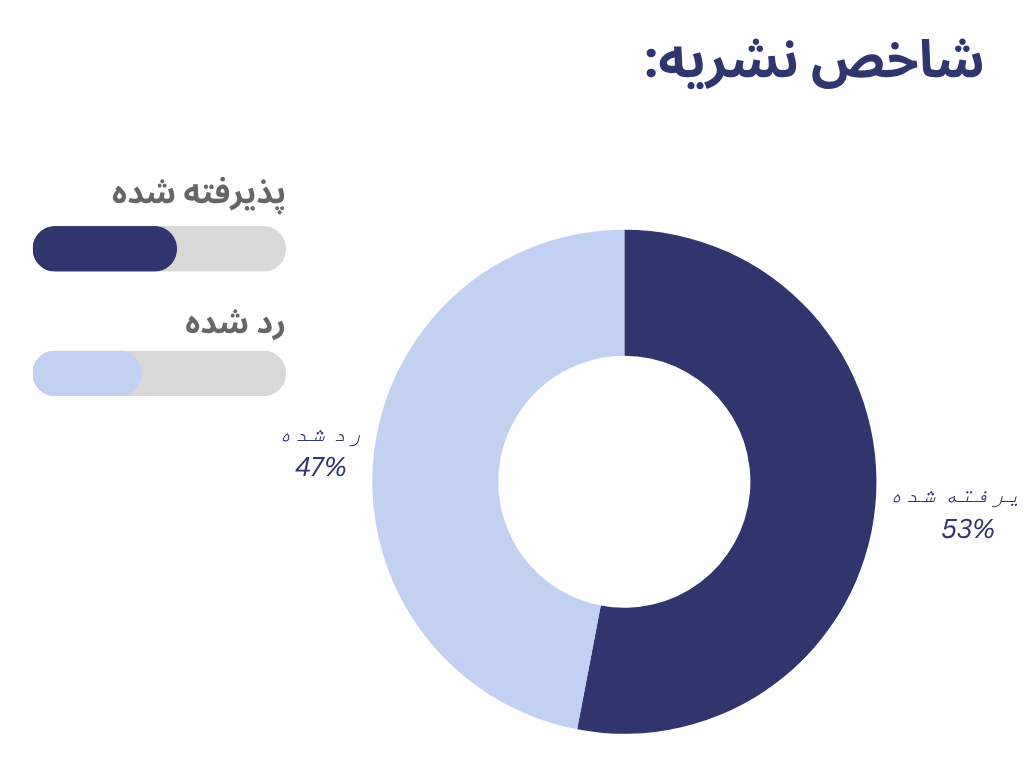ارتقای کارآمدی زنجیرهتامین با استفاده از استراتژیهای ناب و محاسبات توزیعپذیر: یک رویکرد هماهنگ برای کاهش ضایعات و بهینهسازی منابع
چکیده
هدف: این پژوهش با هدف ارتقای کارآمدی زنجیرهتامین به بررسی تلفیق استراتژیهای ناب با معماری محاسبات توزیعپذیر میپردازد. هدف اصلی کاهش انواع ضایعات و بهینهسازی مصرف منابع از طریق هماهنگسازی فرآیندها و بهرهگیری از فناوریهای نوین پردازشی است.
روششناسی پژوهش: در این مطالعه، یک معماری سهلایهای برای پیادهسازی همزمان مفاهیم ناب و ساختار محاسبات توزیعپذیر طراحی شده است. لایه اول به فراهمسازی دسترسی آنی به دادهها در سراسر زنجیرهتامین میپردازد. لایه دوم وظیفه هماهنگسازی فرآیندهای ناب با تقاضای واقعی را بر عهده دارد و لایه سوم نیز توزیع بهینه دادهها با قابلیت مشاهدهپذیری و کنترلپذیری را فراهم میسازد. الگوریتمهایی برای مدیریت رفتار گرهها و جلوگیری از بروز اختلال در شبکه، ارایه شدهاند.
یافتهها: نتایج حاصل از پیادهسازی این رویکرد ترکیبی نشان میدهد که ساختار پیشنهادی باعث کاهش موثر ضایعات ناشی از تولید بیش از نیاز، نقص در محصول، حملونقلهای غیرضروری، زمانهای انتظار و پردازشهای زاید میشود. همچنین، کاهش سطح موجودی، بهبود جریان اطلاعات، افزایش چابکی و توان پاسخگویی سریع به تغییرات تقاضا از دیگر مزایای سیستم طراحیشده، است.
اصالت/ارزش افزوده علمی: نوآوری این پژوهش در ترکیب همزمان مفاهیم ناب با فناوری محاسبات توزیعپذیر و ارایه یک معماری لایهای منسجم برای ارتقای عملکرد زنجیرهتامین است. این چارچوب میتواند بهعنوان مدلی هوشمند و آیندهنگر برای طراحی زنجیرههای تامین کارآمد، منعطف و کمهزینه در صنایع مختلف مورد استفاده قرار گیرد.
کلمات کلیدی:
کارآمدی، زنجیرهتامین ناب، محاسبات توزیعپذیر، کاهش ضایعات، بهینهسازی منابعمراجع
- [1] Wamba, S. F., Dubey, R., Gunasekaran, A., & Akter, S. (2020). The performance effects of big data analytics and supply chain ambidexterity: The moderating effect of environmental dynamism. International journal of production economics, 222, 107498. https://doi.org/10.1016/j.ijpe.2019.09.019
- [2] Bortolini, M., Calabrese, F., Galizia, F. G., & Mora, C. (2022). A three-objective optimization model for mid-term sustainable supply chain network design. Computers & industrial engineering, 168, 108131. https://doi.org/10.1016/j.cie.2022.108131
- [3] Hashemi-Amiri, O., Ghorbani, F., & Ji, R. (2023). Integrated supplier selection, scheduling, and routing problem for perishable product supply chain: A distributionally robust approach. Computers & industrial engineering, 175, 108845. https://doi.org/10.1016/j.cie.2022.108845
- [4] Wu, G., de Carvalho Servia, M. Á., & Mowbray, M. (2023). Distributional reinforcement learning for inventory management in multi-echelon supply chains. Digital chemical engineering, 6, 100073. https://doi.org/10.1016/j.dche.2022.100073
- [5] Lee, K. J., Tilling, K. M., Cornish, R. P., Little, R. J. A., Bell, M. L., Goetghebeur, E., … ., & Carpenter, J. R. (2021). Framework for the treatment and reporting of missing data in observational studies: The treatment and reporting of missing data in observational studies framework. Journal of clinical epidemiology, 134, 79–88. https://doi.org/10.1016/j.jclinepi.2021.01.008
- [6] Dong, F., Jin, D., Zhao, X., Han, J., & Lu, W. (2022). A non-cooperative game approach to the robust control design for a class of fuzzy dynamical systems. ISA transactions, 125, 119–133. https://doi.org/10.1016/j.isatra.2021.06.031
- [7] Decardi-Nelson, B., & Liu, J. (2023). Computing control invariant sets of cascade nonlinear systems: Decomposition and distributed computing. Computers & chemical engineering, 171, 108142. https://doi.org/10.1016/j.compchemeng.2023.108142
- [8] Gomes, K. R. R., Perera, H. N., Thibbotuwawa, A., & Sunil-Chandra, N. P. (2023). Comparative analysis of lean and agile supply chain strategies for effective vaccine distribution in pandemics: A case study of COVID-19 in a densely populated developing region. Supply chain analytics, 3, 100022. https://doi.org/10.1016/j.sca.2023.100022
- [9] Negi, S. (2021). Supply chain efficiency framework to improve business performance in a competitive era. Management research review, 44(3), 477–508. https://doi.org/10.1108/MRR-05-2020-0272
- [10] Strimovskaya, A., Barykin, S., Volkova, E., Tsyplakova, E., Sinko, G., Kuzmenkova, V., & Krasilnikov, A. (2023). Multi-level conceptual model of efficiency control in supply chain management. IFAC-papersonline, 56(2), 1809–1814. https://doi.org/10.1016/j.ifacol.2023.10.1894
- [11] Fu, S., Ge, Y., Hao, Y., Peng, J., & Tian, J. (2024). Energy supply chain efficiency in the digital era: Evidence from China’s listed companies. Energy economics, 134, 107597. https://doi.org/10.1016/j.eneco.2024.107597
- [12] Kim, C. K., Lee, C., Kim, D., Cha, H., & Cheong, T. (2023). Enhancing supply chain efficiency: A two-stage model for evaluating multiple sourcing and extra procurement strategy optimization. Sustainability, 15(22). https://doi.org/10.3390/su152216122
- [13] Madhani, P. M. (2020). Enhancing supply chain efficiency and effectiveness with lean six sigma approach. International journal of project management and productivity assessment (IJPMPA), 8(1), 40–65. https://doi.org/10.4018/IJPMPA.2020010103
- [14] Daneshvar, M., Hajiagha, S. H. R., Tupėnaitė, L., & Khoshkheslat, F. (2020). Effective factors of implementing efficient supply chain strategy on supply chain performance. Technological and economic development of economy, 26(4), 947–969. https://doi.org/10.3846/tede.2020.12827
- [15] Fischer, J. H., Pfeiffer, D., Hellingrath, B., Scavarda, L. F., & Martins, R. A. (2014). Robust parameter setting of supply chain flexibility measures using distributed evolutionary computing. Procedia cirp, 19, 75–80. https://doi.org/10.1016/j.procir.2014.05.023
- [16] Delporte, C., Fauconnier, H., Rajsbaum, S., & Raynal, M. (2022). Distributed computability: Relating k-immediate snapshot and x-set agreement. Information and computation, 285, 104815. https://doi.org/10.1016/j.ic.2021.104815
- [17] Liu, G., Xiao, Z., Tan, G., Li, K., & Chronopoulos, A. T. (2020). Game theory-based optimization of distributed idle computing resources in cloud environments. Theoretical computer science, 806, 468–488. https://doi.org/10.1016/j.tcs.2019.08.019
- [18] Lukoyanov, E., Kolesov, N., Gruzlikov, A., & Tolmacheva, M. (2022). Models of dynamic systems in diagnostic tasks. Symmetry, 14(7), 1433. https://doi.org/10.3390/sym14071433
- [19] Jaggard, A. D., Lutz, N., Schapira, M., & Wright, R. N. (2017). Dynamics at the boundary of game theory and distributed computing. Association for computing machinery transactions on economics and computation, 5(3), 1–20. https://doi.org/10.1145/3107182
- [20] Shoop, E., Matthews, S. J., Brown, R., & Adams, J. C. (2025). Hands-on parallel & distributed computing with Raspberry Pi devices and clusters. Journal of parallel and distributed computing, 196, 104996. https://doi.org/10.1016/j.jpdc.2024.104996
- [21] Dhamal, S., Ben-Ameur, W., Chahed, T., Altman, E., Sunny, A., & Poojary, S. (2018). A stochastic game framework for analyzing computational investment strategies in distributed computing. https://doi.org/10.48550/arXiv.1809.03143
- [22] Marden, J. R., & Shamma, J. S. (2018). Game-theoretic learning in distributed control. In Handbook of dynamic game theory (pp. 511–546). Cham: Springer international publishing. https://doi.org/10.1007/978-3-319-44374-4_9
- [23] Purohit, R., Chowdhary, K. R., & Purohit, S. D. (2023). On the design and analysis of parallel and distributed algorithms. https://doi.org/10.48550/arXiv.2311.05857
- [24] Sarkar, L. (2014). Distributed systems: Basic algorithms. University of Edinburgh.
- [25] Herlihy, M., Kozlov, D., & Rajsbaum, S. (2013). Distributed computing through combinatorial topology. Newnes.
- [26] Ali, M. F., & Khan, R. Z. (2015). Distributed computing: An overview. International journal of advanced networking and applications, 7(1), 2630. https://www.researchgate.net/publication/280977301
- [27] Bouneb, Z. E. A. (2022). A distributed algorithm for computing groups in IoT systems. International journal of software science and computational intelligence (IJSSCI), 14(1), 1–21. https://doi.org/10.4018/IJSSCI.300363
- [28] Karishma, & Kumar, H. (2023). A new hybrid particle swarm optimizationalgorithm for optimal tasks scheduling in distributed computing system. Intelligent systems with applications, 18, 200219. https://doi.org/10.1016/j.iswa.2023.200219
- [29] Madisetti, V. K., & Panda, S. (2021). A dynamic leader election algorithm for decentralized networks. Journal of transportation technologies, 11(3), 404–411. https://doi.org/10.4236/jtts.2021.113026
- [30] Zhao, N., Hong, J., & Lau, K. H. (2023). Impact of supply chain digitalization on supply chain resilience and performance: A multi-mediation model. International journal of production economics, 259, 108817. https://doi.org/10.1016/j.ijpe.2023.108817
- [31] Liu, Y., & Jin, M. (2023). Does supply chain network centrality affect firm cost stickiness? Finance research letters, 58, 104459. https://doi.org/10.1016/j.frl.2023.104459
- [32] Saddikutti, V., Gudavalleti, P. K., & Singh, M. P. (2022). Lean and legacy supply chains for coordinated demand driven production to handle disruptions. IFAC-papersonline, 55(10), 2846–2851. https://doi.org/10.1016/j.ifacol.2022.10.162
- [33] Senthil, J., & Muthukannan, M. (2022). Development of lean construction supply chain risk management based on enhanced neural network. Materials today: Proceedings, 56, 1752–1757. https://doi.org/10.1016/j.matpr.2021.10.456
- [34] Xu, L., Mak, S., & Brintrup, A. (2021). Will bots take over the supply chain? Revisiting agent-based supply chain automation. https://doi.org/10.48550/arXiv.2109.01703
- [35] Chopra, S., & Sodhi, M. (2014). Reducing the risk of supply chain disruptions. MIT sloan management review, 55(3), 73–80. https://sloanreview.mit.edu/article/reducing-the-risk-of-supply-chain-disruptions/
- [36] Zhao, P., Yin, S., Han, X., & Li, Z. (2021). Research on lean supply chain network model based on node removal. Physica A: Statistical mechanics and its applications, 567, 125556. https://doi.org/10.1016/j.physa.2020.125556
- [37] Maqueira, J. M., Novais, L. R., & Bruque, S. (2021). Total eclipse on business performance and mass personalization: How supply chain flexibility eclipses lean production direct effect. Supply chain management: an international journal, 26(2), 256–278. https://doi.org/10.1108/SCM-02-2020-0083
- [38] Dwivedi, S. K., Amin, R., & Vollala, S. (2020). Blockchain based secured information sharing protocol in supply chain management system with key distribution mechanism. Journal of information security and applications, 54, 102554. https://doi.org/10.1016/j.jisa.2020.102554
- [39] Boskabadi, A., Mirmozaffari, M., Yazdani, R., & Farahani, A. (2022). Design of a distribution network in a multi-product, multi-period green supply chain system under demand uncertainty. Sustainable operations and computers, 3, 226–237. https://doi.org/10.1016/j.susoc.2022.01.005
- [40] Validi, S., Bhattacharya, A., & Byrne, P. J. (2014). A case analysis of a sustainable food supply chain distribution system—A multi-objective approach. International journal of production economics, 152, 71–87. https://doi.org/10.1016/j.ijpe.2014.02.003
- [41] Dhamal, S., Ben-Ameur, W., Chahed, T., Altman, E., Sunny, A., & Poojary, S. (2022). Strategic investments in distributed computing: A stochastic game perspective. Journal of parallel and distributed computing, 169, 317–333. https://doi.org/10.1016/j.jpdc.2022.07.012
- [42] Ikevuje, A. H., Anaba, D. C., & Iheanyichukwu, U. T. (2024). Optimizing supply chain operations using IoT devices and data analytics for improved efficiency. Magna scientia advanced research and reviews, 11(2), 70–79. https://doi.org/10.30574/msarr.2024.11.2.0107
- [43] Bellingeri, M., & Cassi, D. (2018). Robustness of weighted networks. Physica A: Statistical mechanics and its applications, 489, 47–55. https://doi.org/10.1016/j.physa.2017.07.020
- [44] Bracha, G. (1987). Asynchronous Byzantine agreement protocols. Information and computation, 75(2), 130–143. https://doi.org/10.1016/0890-5401(87)90054-X
- [45] King, V., & Saia, J. (2013). Byzantine agreement in polynomial expected time. Proceedings of the forty-fifth annual ACM symposium on theory of computing (pp. 401–410). New York, NY, USA: Association for computing machinery. https://doi.org/10.1145/2488608.2488658
- [46] Liu, M., Song, T., Hu, J., Yang, J., & Gui, G. (2019). Deep learning-inspired message passing algorithm for efficient resource allocation in cognitive radio Networks. IEEE transactions on vehicular technology, 68(1), 641–653. https://doi.org/10.1109/TVT.2018.2883669
- [47] Métivier, Y., Robson, J. M., Saheb-Djahromi, N., & Zemmari, A. (2011). An optimal bit complexity randomized distributed MIS algorithm. Distributed computing, 23(5), 331–340. https://doi.org/10.1007/s00446-010-0121-5
- [48] Schneider, J., & Wattenhofer, R. (2008). A log-star distributed maximal independent set algorithm for growth-bounded graphs. Proceedings of the twenty-seventh acm symposium on principles of distributed computing (pp. 35–44). New York, NY, USA: Association for computing machinery. https://doi.org/10.1145/1400751.1400758
- [49] Frischknecht, S., Keller, B., & Wattenhofer, R. (2013). Convergence in (social) influence networks. Distributed computing (pp. 433–446). Berlin, Heidelberg: Springer Berlin Heidelberg. https://doi.org/10.1007/978-3-642-41527-2_30
- [50] Ayala, V., & Da Silva, A. (2002). Structural properties of the bounded control set of a linear system. https://www.researchgate.net/publication/339015921
- [51] Joseph, G. (2023). Output controllability of a linear dynamical system with sparse controls. IEEE transactions on control of network systems, 10(1), 147–156. https://doi.org/10.1109/TCNS.2022.3188484







